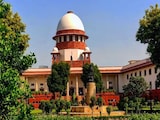The 'Millennium eruption,' thought to have occurred somewhere around 946 AD, was one of the largest in recorded history.
With a roar that sounded like the pounding of a divine drum, the peak of towering Mount Paektu was blasted into the air. The resulting plume of volcanic material turned daytime into darkness and blanketed the landscape for hundreds of miles in a thick layer of snow-white ash. Meanwhile, a fast-moving flow of toxic gas and superheated rock barreled down the mountainside, obliterating everything in its path. An ancient emperor was said to be so alarmed by the devastation he set all convicts in the country free.
The "Millennium eruption," thought to have occurred somewhere around 946 AD, was one of the largest in recorded history - second only to a blast from Mount Tambora in 1815. But little is known about its source, a 9,000-foot volcano straddling the divide between China and North Korea. The mountain, like so much else beyond that border, has long been a mystery.
That is, until it started rumbling again in the early 2000s. Faced with the possibility of an eruption like it hasn't seen in 1,000 years, the insular North Korean government took an almost unprecedented step: It asked for help from the rest of the world.
It would take years - not to mention some intense scientific diplomacy - to get researchers out on Mount Paektu to map the layers of rock and magma beneath its surface.
"It was quite a special experience the first time," co-author James Hammond of the University of London told CBS in 2014. "Very much a voyage into the unknown."
On Friday, the unknown became a little less so. In the journal Science Advances, an international team of researchers from North Korea, China, the United States and Britain published the first-ever survey of the volcano's subsurface structure.
First, the good news: The researchers failed to find any liquid magma pooling near the surface - which might have indicated that another catastrophic blow-up was in the works.
But they did find a significant layer of partially melted rock beneath the mountain that begs to be studied further.
"One of the challenges now is to go beyond simply saying there's magma in the crust, discovering instead how it's sitting, how much there is and what are the implications," Hammond told New Scientist. "It's only when it gets to a certain amount and a certain overpressure that it will erupt."
It isn't only North Korea's insularity that makes Mount Paektu an enigma. The geological forces that created it are elusive, even to the scientists who study it. Most volcanoes tend to spring up where tectonic plates collide, pushing hot rock and magma toward the surface of the Earth. But Mount Paektu is parked pretty far from the edge of the Amur plate.
Instead, the volcano may be caused by a hot spot in the mantle - the thick layer of hot rock that churns below the Earth's crust. Or it could have been formed by forces that aren't understood yet.
"That's one of the big mysteries," U.S. Geological Survey volcanologist Kayla Iacovino told National Geographic.
Adding to Mount Paektu's near-mythical status are centuries of history and myth. The Manchu, an ethnic minority in China, believe their ancestors were born there. According to Korean mythology, the mountain was the birthplace of the founder of the Korean kingdom. During World War II, Korean guerrilla fighters built secret camps on its slopes from which the country's first leader, Kim Il Sung, led attacks against the Japanese. Tens of thousands of Koreans still visit the site for political indoctrination tours every summer, according to the Associated Press.
This made an international survey of Mount Paektu a politically tricky endeavor. But in 2002, when small earthquakes started shaking the mountain's slopes - just 60 miles away from a North Korean nuclear test site - concern about the volcano transcended borders.
"The volcano has erupted big time in the past, and were it to happen again, the Chinese, South Korean and Japanese economies could all be affected," University of California in Santa Cruz professor James Gill, who has worked on the Chinese side of the volcano (but was not involved in the latest study) told the BBC in 2013.
It wasn't good for anyone that "one of the world's biggest volcanoes is [sitting] in a backwater of the Cold War," he added.
Starting in 2011, western scientists were invited to visit the North's field stations on the Korean side of the mountain. They deployed seismometers - which help illuminate the Earth's interior by measuring how waves travel through it - and collected rock samples that could help interpret the volcano's past.
But some standard geology tools had to be scrapped because of international sanctions against bringing in anything with a military use, according to Wired. Even getting approval to import seismometers took two years. And then there was the slow process of getting everything translated by government interpreters (as Wired noted, "some might call them minders").
Despite all that, Hammond is optimistic about the collaboration. He told the New Scientist that he will be returning to Pyongyang this week to talk with his North Korean colleagues about their next 12 months of research - and to toast to their publication (the first such collaboration in a high profile Western journal, Hammond said) with a glass of soju, or rice liquor.
Then they'll climb up the mountain and get back to work.
"The Earth itself doesn't pay any attention to borders," R. Laurence Davis, a geologist at the University of New Haven in Connecticut who was not part of this project, told the Christian Science Monitor. "It does what it does."
© 2016 The Washington Post
(This story has not been edited by NDTV staff and is auto-generated from a syndicated feed.)
The "Millennium eruption," thought to have occurred somewhere around 946 AD, was one of the largest in recorded history - second only to a blast from Mount Tambora in 1815. But little is known about its source, a 9,000-foot volcano straddling the divide between China and North Korea. The mountain, like so much else beyond that border, has long been a mystery.
That is, until it started rumbling again in the early 2000s. Faced with the possibility of an eruption like it hasn't seen in 1,000 years, the insular North Korean government took an almost unprecedented step: It asked for help from the rest of the world.
It would take years - not to mention some intense scientific diplomacy - to get researchers out on Mount Paektu to map the layers of rock and magma beneath its surface.
"It was quite a special experience the first time," co-author James Hammond of the University of London told CBS in 2014. "Very much a voyage into the unknown."
On Friday, the unknown became a little less so. In the journal Science Advances, an international team of researchers from North Korea, China, the United States and Britain published the first-ever survey of the volcano's subsurface structure.
First, the good news: The researchers failed to find any liquid magma pooling near the surface - which might have indicated that another catastrophic blow-up was in the works.
But they did find a significant layer of partially melted rock beneath the mountain that begs to be studied further.
"One of the challenges now is to go beyond simply saying there's magma in the crust, discovering instead how it's sitting, how much there is and what are the implications," Hammond told New Scientist. "It's only when it gets to a certain amount and a certain overpressure that it will erupt."
It isn't only North Korea's insularity that makes Mount Paektu an enigma. The geological forces that created it are elusive, even to the scientists who study it. Most volcanoes tend to spring up where tectonic plates collide, pushing hot rock and magma toward the surface of the Earth. But Mount Paektu is parked pretty far from the edge of the Amur plate.
Instead, the volcano may be caused by a hot spot in the mantle - the thick layer of hot rock that churns below the Earth's crust. Or it could have been formed by forces that aren't understood yet.
"That's one of the big mysteries," U.S. Geological Survey volcanologist Kayla Iacovino told National Geographic.
Adding to Mount Paektu's near-mythical status are centuries of history and myth. The Manchu, an ethnic minority in China, believe their ancestors were born there. According to Korean mythology, the mountain was the birthplace of the founder of the Korean kingdom. During World War II, Korean guerrilla fighters built secret camps on its slopes from which the country's first leader, Kim Il Sung, led attacks against the Japanese. Tens of thousands of Koreans still visit the site for political indoctrination tours every summer, according to the Associated Press.
This made an international survey of Mount Paektu a politically tricky endeavor. But in 2002, when small earthquakes started shaking the mountain's slopes - just 60 miles away from a North Korean nuclear test site - concern about the volcano transcended borders.
"The volcano has erupted big time in the past, and were it to happen again, the Chinese, South Korean and Japanese economies could all be affected," University of California in Santa Cruz professor James Gill, who has worked on the Chinese side of the volcano (but was not involved in the latest study) told the BBC in 2013.
It wasn't good for anyone that "one of the world's biggest volcanoes is [sitting] in a backwater of the Cold War," he added.
Starting in 2011, western scientists were invited to visit the North's field stations on the Korean side of the mountain. They deployed seismometers - which help illuminate the Earth's interior by measuring how waves travel through it - and collected rock samples that could help interpret the volcano's past.
But some standard geology tools had to be scrapped because of international sanctions against bringing in anything with a military use, according to Wired. Even getting approval to import seismometers took two years. And then there was the slow process of getting everything translated by government interpreters (as Wired noted, "some might call them minders").
Despite all that, Hammond is optimistic about the collaboration. He told the New Scientist that he will be returning to Pyongyang this week to talk with his North Korean colleagues about their next 12 months of research - and to toast to their publication (the first such collaboration in a high profile Western journal, Hammond said) with a glass of soju, or rice liquor.
Then they'll climb up the mountain and get back to work.
"The Earth itself doesn't pay any attention to borders," R. Laurence Davis, a geologist at the University of New Haven in Connecticut who was not part of this project, told the Christian Science Monitor. "It does what it does."
© 2016 The Washington Post
(This story has not been edited by NDTV staff and is auto-generated from a syndicated feed.)















